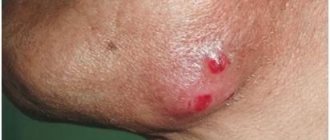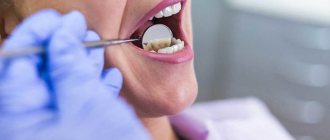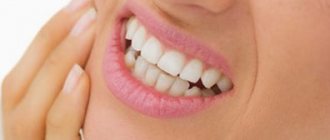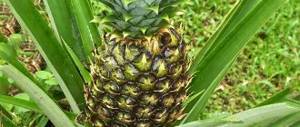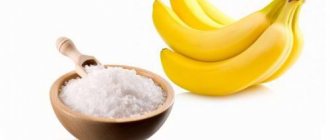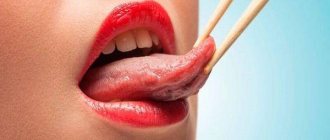The article was checked by an otolaryngologist
Natalya Aleksandrovna Naumova, Medis Clinic
MAKE AN APPOINTMENT WITH AN ENT DOCTOR ONLINE
Pain in the ear when swallowing is a common symptom of many diseases of infectious etiology, characterized by inflammation of the mucous membranes of the nasopharynx, gums, and auditory organs.
Why does a sore throat cause irradiation to the ear area and, vice versa, unpleasant manifestations in the ears are reflected into the larynx, making swallowing difficult? What medications should be used for first aid?
Causes of ear pain when swallowing
If you suddenly experience terrible ear pain when swallowing, you need to figure out why it appeared.
In case of inflammation of the middle or outer, as well as inner ear - otitis, tubo-otitis, mastoiditis, the internal pressure of the Eustachian tube is disrupted, the mucous membranes swell during inflammation, the situation leads to compression and pinching of the adjacent tissues of the pharynx. Ear hurts when swallowing.
With tonsillitis, the inflammatory process is accompanied by thickening and enlargement of the tonsils and lymph nodes; they put excessive pressure on the ear canals. With every swallow, pain radiates from the throat to the ear.
Laryngitis and pharyngitis are also manifested by swelling of the mucous membranes and muscle tissue of the pharynx and larynx. This affects the compression of the tissues of the hearing organs, as well as nerve-impulse reflexion: when swallowing, pain comes from the throat to the ear.
When you have a runny nose from sinusitis or sinusitis, your ear and throat hurt due to purulent discharge getting into the Eustachian tubes. The development of inflammation leads to stagnation of mucus, dilation of blood vessels, and compression of nerve endings by edematous internal epithelium.
The initial symptom of mumps is ear pain caused by viral or bacterial infection of the parotid salivary glands. It provokes pain in the throat when swallowing.
Sinusitis
In a general sense, sinusitis is an inflammation of the paranasal sinuses. They are inhomogeneous in nature and are divided into several groups. Accordingly, inflammatory processes will have different names.
- Ethmoiditis is inflammation of the ethmoidal labyrinth.
- Sinusitis is a lesion of the maxillary sinuses.
- Sphenoiditis is a process in the sinuses of the sphenoid bone.
- Frontitis is an inflammation localized in the frontal sinuses.
The reasons for the development of the pathological process are always approximately the same. This is an acute bacterial infection or viral/fungal infection of the upper respiratory tract.
Often, sinusitis comes as a “pleasant bonus” to the underlying diseases: tonsillitis, otitis media and others. In such a situation, they talk about inflammation of the sinuses as a complication of the disease.
The symptoms are very typical and characteristic. It's quite difficult to confuse her. Among the manifestations are:
- Copious discharge of mucus from the nasal passages. This happens, however, not always. Thus, in the catarrhal form, congestion prevails.
- Discomfort in the nasal passages. There is a feeling of pressure, compression, pulsation.
- Increase in body temperature to significant levels. Also not axiomatic. Normal thermometer readings are also possible. If hyperthermia is present, we are talking about relatively high numbers of 38-39 degrees and even a little higher in case of an acute process.
- Sore throat, radiating to the ear and a feeling of stuffiness in one or two ears at once.
- Exudation. In later stages, green or yellow pus oozes from the nasal passages.
- General intoxication and its manifestations: chills, feeling hot, weakness, headaches and other symptoms.
The treatment is specific. It involves the use of several pharmaceutical types of medications. Among them are anti-inflammatory drugs, antibiotics (mandatory), antiviral drugs, antifungal drugs (depending on the type of pathogen).
The notorious puncture of the sinuses or “puncture” is an extreme measure, which is resorted to extremely rarely due to the traumatic nature.
Interesting:
In European and American practice, puncture is not used at all except in cases that pose a danger to the patient’s life. In Russia and the CIS countries, puncture is practiced more often, since it is the simplest and cheapest procedure.
Read more about the disease in this article. The tactics for treating sinusitis at home are described here.
Secondary causes of the pathological condition
There are a number of additional reasons that cause pain.
The consequences of inflammatory bacterial processes in the lymph nodes caused by exacerbations of arthrosis, arthritis, osteochondrosis, scoliosis also cause discomfort in the ear canal and larynx during swallowing.
Caries, gingivitis, stomatitis - diseases of the teeth and gums, if not treated in a timely manner, lead to purulent inflammation of the mucous membranes not only of the oral cavity, but also of the throat and Eustachian tube. Symptoms: pain in the ear, throat, jaw.
Diphtheria, scarlet fever, measles, whooping cough, chickenpox - all these dangerous childhood diseases are often accompanied by a syndrome of severe sore throat radiating to the ear. The main distinguishing signs of these infections are the formation of various types of rashes on the body, throat, face, and limbs.
If pain symptoms are detected in the throat or ear against the background of skin rashes, you must immediately call an ambulance. This will protect the child from terrible consequences: deformation of appearance with pockmarks, loss of vision and hearing, and sepsis. It will also save all children from the entrance and yard at their place of residence from infection.
Otitis externa
With this type of disease, damage occurs to the auricle and external auditory canal. Ear pain is the main symptom. The main cause of discomfort is considered to be a bacterial infection. This type of illness is very rare.
Sudden, piercing pain in the ears followed by deafness indicates a ruptured eardrum. B. impossible because of the cold. The tympanic ligation is absorbed into the middle ear and tears. Small tears in the eardrum usually heal on their own. If not, the defect is covered with foil or covered with the body's own material. Until the injury heals, bacteria can invade the ear canal and cause otitis media.
Ear drops or rinses threaten the inner ear and are therefore contraindicated in cases of tympanic rupture. Severe pain and discomfort in the ear and its surroundings can be caused by chickenpox viruses. They spread along the facial nerve and vestibulocochlear nerve and cause oticus zoster. Eczema is difficult to detect by location on or in the ear and often occurs only a few days after other symptoms. On the other hand, facial paralysis should not be overlooked: the facial muscles are paralyzed on one side and the face is asymmetrically deformed.
Ear pain may increase when talking, chewing, or swallowing. The ears feel stuffy, there is redness and... The temperature may rise to 37.5 °C. If the inflammation has spread to the eardrum, discharge may begin from the ear opening. Headache often occurs.
The neuralgia is extremely debilitating and almost unbearable in the facial region. In addition to post-zoster neuralgia, triple neuralgia is very common; neuralgias of the glossopharyngeal or posterior scalp nerves are less common. Normal painkillers don't work, but antiepileptic drugs like carbamazepine do.
Equalization of pressure in the ear is made possible thanks to the Eustachian tube. It connects the nasopharynx to the middle ear, ensuring pressure equalization and therefore good ventilation in the middle ear. If pressure equalization does not occur, significant pain can result. The Eustachian tube is not always open; it can be opened and closed by a muscle. When swallowing, for example, the muscle pulls on the tube and opens it. This is noticeable with a little "hack". The ability to balance pressure differs and is trained individually.
Otitis externa is treated as prescribed by the doctor. To reduce swelling, the doctor prescribes allergy medications (antihistamines). Nonsteroidal anti-inflammatory drugs (Aspirin, Diclofenac, Ketoprofen, Ibuprofen) help reduce pain. The specialist prescribes vitamins or dietary supplements to strengthen the immune system.
Pressure, ears: problems
Typical situations in which pressure equalization is required occur while diving or on a plane. Diving clearly shows the problems that can arise if the pressure is not balanced. Diving without pressure equalization causes the eardrum to bulge inward. If external pressure continues to increase, swelling and eventually bleeding occurs, forcing the body to try to equalize the pressure. It can also cause the eardrum to rupture. The result is balance problems, dizziness and nausea.
Ear pain relief, first aid
What can you do at home? What is strictly contraindicated?
Doctors usually recommend Otipax drops.
Not until examined by a doctor
bury it in the ear, traditional medicine - there are many ways to warm it up. It is absolutely unacceptable to do all this before visiting a doctor. There are a number of reasons for this ban.
In case of a purulent inflammatory process, hot compresses on the area of the ears and nearby will provoke the activation of pathogenic bacteria and increase the rate of their reproduction. As a result, the patient’s condition will worsen as much as possible due to the spread of inflammation to all nearby tissues of neighboring organs.
If the eardrum has ruptures, punctures, drops will not bring relief. They should not be used without a doctor’s recommendation if there is acute pain in the ear.
How to act
To calm the pain before visiting a doctor, you are allowed to take Ibuprofen, but only a tablet. Doctors' recommendations:
- Place vasoconstrictor drops inside the nasal openings: Nazol, Galazolin, Naphthyzin.
- The drops will reduce the swelling of the mucous membranes of the eustachian passages, help equalize the pressure, and stop the development of inflammation.
- The pain syndrome is partially reduced if you cover the ear with a napkin, protecting it from contact with hair, clothing and wind.
- To prevent the development of infection, a sore throat should be rinsed with Miramistin, Chlorophyllipt or saline solution.
| A drug | Photo | Price |
| Ibuprofen | From 15 rub. | |
| Nazol | From 160 rub. | |
| Galazolin | From 37 rub. | |
| Naphthyzin | From 23 rub. | |
| Miramistin | From 218 rub. | |
| Chlorophyllipt | From 115 rub. |
It is not recommended to take other medications without a doctor's prescription. Patients need to beware of antibiotics, as they can cause severe allergic shock in a child.
Treatment
For the purpose of treatment, symptomatic and etiotropic drugs are used. Therapy will depend on the causative disease. The choice of remedies is made by the doctor after research and identification of the main factor of pain in the ears when swallowing.
Important! For otitis media, treatment is performed at home; for purulent processes and complicated pathologies, hospitalization is required.
Treatment may include the following:
- tablets, drops, ointments;
- physiotherapeutic procedures;
- folk remedies;
- surgical intervention.
Medication
Drug therapy may include antibacterial drugs, antiviral, antiseptic, vitamin, and anti-inflammatory drugs. For bacterial infections and purulent processes, antibiotics are always indicated. For this purpose, ear drops Anauran and Sofradex .
For pain relief in children and adults for any pathology, non-steroidal anti-inflammatory drugs are used - Nurofen, Paracetamol, Ibuprofen . They can be prescribed in the form of tablets, syrups and rectal suppositories, depending on the age of the patient.
For viral infections, antiviral drops are indicated - Garazon, Otofa, Normax, Cipropharm . They have a complex effect, simultaneously eliminating the inflammatory process and relieving pain.
Physiotherapeutic
UHF ear (painless procedure).
Physiotherapeutic procedures are used to treat otitis and other inflammatory diseases of the ENT organs. They have general contraindications - low blood pressure, pathologies of the hematopoietic organs, fever, oncology, disorders of the cardiovascular system.
The doctor may prescribe the following procedures:
- UHF - about 5 procedures lasting up to 7 minutes are performed;
- electrophoresis - a solution of zinc sulfate and antibiotics are used;
- microwave therapy - exposure to an electromagnetic field for 5 minutes;
- ultraviolet irradiation - warming up takes about 15 minutes.
Traditional methods
Use traditional methods only after consulting a doctor!
After consulting with your doctor, you can use some folk remedies for pain relief. These can be solutions, compresses, applications.
Types of drug treatment depending on the etiology of the disease
You should not overuse self-medication and adopt the experience of friends. Medical statistics show a huge number of examples of premature disability due to incorrect use of medications.
Groups of pharmaceuticals effective for inflammatory infectious diseases of the throat:
- antiseptic drugs;
- antiviral;
- combined agents - antiseptic and anesthetic.
Antiseptic drugs
They are necessary to destroy microbes in sore throats, stomatitis, pharyngitis, and laryngitis of bacterial etiology. They are used topically: for gargling, irrigating the throat to relieve the inflammatory process, reduce pain, and regenerate affected mucous membranes.
To relieve sore throat and itching, there are a number of drugs popular among the population:
| A drug | Photo | Price |
| Tantum Verde | From 261 rub. | |
| Grammidin | From 232 rub. | |
| Hexoral spray | From 275 rub. | |
| Stopangin | From 156 rub. |
The forms of release of antiseptics are varied:
- solutions;
- aerosols;
- lozenges;
- tablets, but dissolving ones;
- lollipops.
Antiviral agents
They are used if a sore throat radiating to the ear area is caused by diseases of a viral nature: laryngitis, influenza, pharyngitis, ARVI, herpangina:
| A drug | Photo | Price |
| Arbidol | From 162 rub. | |
| Kagocel | From 212 rub. | |
| Teraflu | From 161 rub. | |
| Tsitovir | From 242 rub. | |
| Remantadine | From 71 rub. | |
| Anaferon | From 206 rub. | |
| Coldrex | From 192 rub. | |
| Amiksin | From 593 rub. | |
| Tamiflu | From 1276 rub. |
They destroy viruses, reduce throat swelling, and increase the body's immune defense. Release forms for children are syrups, for adults - capsules, tablets.
Otitis
Otitis is an inflammation of the inner, middle or outer ear. The auditory canal has an extremely complex structure, which is why this disease is considered dangerous. First of all, its complications.
The greatest likelihood of developing otitis is observed in young children due to the structural features of the auditory tube. Also often affected are swimmers, installers at high altitudes, pilots, flight attendants, divers, etc., which is associated with severe strain on the ear.
The causes of the development of pathology can be divided into two groups: infectious and non-infectious. The former, of course, are many times more common.
Non-infectious factors relate to compression of the eardrum as a result of changes in pressure. As already mentioned, people who work at heights or who like to dive into bodies of water to great depths suffer.
Otitis media is accompanied by typical symptoms. Observed:
- Unilateral pain in the affected ear. At the same time, it goes down the throat, which at first glance is quite strange. In fact, we are talking about the proximity of anatomical structures, which is why symptoms occur quite often. The pain is stabbing, shooting. In the acute form of otitis, a significant decrease in the patient’s quality of life is observed. The chronic form is somewhat easier to tolerate.
- Hyperemia of the dermal layer localized near the ear. This does not always happen, but it is possible.
- Increase in body temperature to subfebrile or febrile levels.
- Headache. Due to innervation.
- Dizziness. Usually with damage to the inner ear, which is explained by disruption of the vestibular apparatus.
- Noise in one or both ears.
- Feeling of congestion, loss of normal hearing.
- Discharge from the ear. Usually serous or purulent in nature.
There are three types of otitis:
- Damage to the inner ear. The most severe form of the pathological process. Characterized by a violation of vestibular functions.
- Middle ear damage. Damage to the outer ear. It occurs more often than others. Affects the eardrum.
The disease is dangerous due to its complications. This includes possible irreversible hearing loss, complete loss on the affected side, meningitis, sepsis and even death. Otitis media is most dangerous for young children.
There are other pathologies that can manifest themselves in a similar way: scarlet fever, throat cancer, benign tumors, chicken pox, diphtheria and some others. But most often, the symptoms in question, such as pain in the throat and ear, simultaneously occur during the pathological processes described above.
Drugs with combined effects: antiseptic + anesthetic
They are used for pain relief in case of intense discomfort, as well as suppression of activity and destruction of pathogenic microorganisms of any nature:
| A drug | Photo | Price |
| Lysobacter | From 288 rub. | |
| Kameton | From 45 rub. | |
| Strepsils | From 179 rub. | |
| Ingalipt | From 84 rub. | |
| Septolete | From 205 rub. | |
| Panadol | From 53 rub. |
Available in the form of absorbable tablets, lozenges, sprays, solutions, lozenges.
Medicines
What should you do when you swallow and have a sore throat and ear? When otitis media is detected at the initial stage, warm compresses and drops in the ears are effective. For severe pathologies, antibiotic therapy is prescribed.
Local medications are often used to treat otitis media:
- "Sofradex". This is a remedy that has a strong antibacterial, analgesic, anti-allergenic and anti-inflammatory effect. Drops allow you to destroy streptococci and staphylococci. You need to drip 3-4 drops up to 3 times a day to eliminate swelling, itching, pain, and a feeling of congestion.
- "Garazón." The medicine is available in the form of drops. It has a bactericidal, antifungal, antiviral effect. Using Garazon eliminates pain and reduces the intensity of inflammation. You need to instill 3-4 drops 3 times a day.
- "Anauran." A combined drug that has an antibacterial and analgesic effect. You should drip 4-5 drops into the sore ear up to 6 times a day.
If pain occurs due to inflammation of the pharynx and tonsils, then the doctor will prescribe antibiotic therapy, lozenges, which have a local anti-inflammatory and analgesic effect.
Antibiotics
Prescribed for the treatment of ear, throat, and nose diseases of a bacterial nature. Effectively destroys the following viruses and bacteria:
- staphylococci;
- streptococci;
- pneumococci;
- gonococci;
- Haemophilus influenzae;
- tuberculosis;
- diphtheria.
Preparations:
- Amoxicillin.
- Trachisan.
- Flemoclav.
- Amoxiclav.
They are available in tablets, but all antibiotics can be taken only with the permission of doctors.
How to relieve pain in the hearing organs
In cases where it is painful to swallow and the ear hurts due to otitis media, tubo-otitis, painkillers, anti-inflammatory or antibacterial agents are used.
Ear drops
Known or frequently prescribed medicinal anti-inflammatory and analgesic solutions, which include several drugs.
Otipax is a combination drug. Lidocaine contains a powerful analgesic, the substance Phenazone, characterized by anti-inflammatory, vasoconstrictor, hemostatic properties.
Anauran . The composition contains 2 antibiotics, characterized by a wide spectrum of antimicrobial action and the anesthetic Lidocaine. The drops have anti-inflammatory and antibacterial properties. Used for severe pain in cases of purulent infectious diseases of the ear.
Garazon drops . Medicinal properties: antibacterial, antiviral, antifungal effects. Reduce inflammation, swelling, pain, burning, relieve lumbago and ear congestion.
Sofradex . Drops are effective for destroying pathogens of bacterial infections: streptococci, staphylococci. They have antimicrobial, analgesic, and anti-inflammatory properties. Do not cause allergies. Reduce swelling of the mucous membranes, hyperemia, itching in the ear.
Antiseptic drops . Hydrogen peroxide, Miramistin. Alcohol preparations: Furacilin, Camphor, Boric alcohol.
| A drug | Photo | Price |
| Otipax | From 254 rub. | |
| Anauran | From 254 rub. | |
| Sofradex | From 330 rub. | |
| Miramistin | From 218 rub. |
Each type of medicinal drops has some unpleasant side effects and contraindications, so they should be used after medical consultation. But only an otolaryngologist can determine damage to the eardrum when drops cannot be used.
Antibiotics in tablets, ear injections
In severe cases of purulent otitis, tubo-otitis, and other infectious diseases caused by bacterial microorganisms, antibiotics are prescribed for internal use.
- tablets, capsules: Amoxicillin, Ampicillin, Ciprofloxacin, Spiramycin;
- injection: Netilmicin, Cefazolin.
When the ear hurts when swallowing, treatment must be comprehensive, and also simultaneously for the area of the auditory canals and the respiratory tract, since the inflammatory process has covered a wide area.
It is important to drink more liquid to quickly remove toxins, as well as change your diet. It is necessary to exclude foods that irritate the mucous membranes of the nasopharynx, as well as foods that can injure it. Ears must be covered.
Immediate assistance measures
If ear pain occurs when swallowing, especially in a child, then it is necessary to take urgent measures as soon as possible. If it is not possible to promptly contact a doctor, it is necessary to create conditions for the relief of pain syndromes. To do this, it is recommended to follow the algorithm of actions, and the ear pain will go away.
- Naphthyzine is most often used to instill drops into the nasal cavity to narrow blood vessels. This measure helps reduce swelling in the mucous membrane area.
- Take one tablet of an analgesic medicinal composition, Ibuprofen is recommended for children, other drugs can be used for adults, and pain in the ears when swallowing will disappear immediately.
- Protect the sore ear from the negative effects of external factors, including moisture, wind, cold. For this purpose, a compress is applied or a special cotton wool turunda is used.
- If it hurts to chew, it is necessary to rinse the nasal cavity with a physical solution or simply drip a few drops of it every few hours in order to moisturize the mucous membrane.
- If the integrity of the eardrum is normal, you can put a turunda inside, which is soaked in oil in advance. Pain when swallowing will disappear after a short time.
It is important to remember that such treatment may be strictly temporary and should be used under the supervision of a physician.
Folk remedies
Plant decoctions have an analgesic effect:
- mint;
- oregano;
- fragrant rue;
- bloodroot;
- caraway;
- meadow lumbago.
A teaspoon per 150 ml of water, leave for 15 minutes in a thermos.
If you have a sore throat, or if there is pain in the hearing organs, you need to prepare drinks from medicinal herbs that have anti-inflammatory, bactericidal, and sedative properties for gargling:
- chamomile;
- elecampane;
- calendula;
- St. John's wort;
- oak bark;
- sage.
To gargle and gargle in case of purulent inflammation of the throat, teeth, or if the ear hurts when swallowing, it is necessary to use solutions with salt; it, by changing the osmotic pressure of the cells, draws out all pyogenic bacteria from them. Mix a teaspoon into half a glass of water.
Fungal infections or candidiasis are effectively removed by soda solutions. A teaspoon of soda - in 100 ml of water.
After a cold, tea, rose hip drink, black currant, and lemon are useful to boost immunity.
Treatment of tubootitis: disinfection of the ear cavity at home is done with hydrogen peroxide 3%.
All herbs can provoke an allergy attack; you need to use folk decoctions carefully.
Possible complications of pain in the ear and swallowing
Adverse consequences of diseases of the ear and throat organs occur in cases of improper self-medication, untimely and incorrect use of medications.
Complications of otitis, tubootitis:
- hearing loss or complete hearing loss;
- abscess of intracranial tissue, meningitis;
- mastoiditis;
- partial paralysis of the facial nerves.
Complications of throat diseases:
- otitis media and internal;
- swelling of the pharynx and larynx;
- phlegmon;
- purulent abscess.
The cause and consequence of pain in the hearing organs, radiating to the throat, is difficult for the patient to perceive, and pain in the larynx, accompanied by pain in the ear, is cancer.
The causes of cancer are unknown to doctors, and not every doctor is able to make a diagnosis, so if the patient’s home is far from the center, it is necessary for a paramedic - a family practice doctor - to be referred to a regional hospital. Laryngeal cancer today can be effectively treated if the disease is left untreated.
How to treat?
- It is difficult to recommend anything specific regarding treatment. Here, a lot depends on what specific disease the patient has. Due to the fact that the corresponding ailments are most often caused by glossitis, it should be considered first.
- For relief and therapy in this case, the drug Imudon is used.
- Stomatitis is treated by taking various antiviral agents. Actually, similar drugs are used for other diseases, one of the symptoms of which is a violation of the mucous membrane. Here it is possible to use both folk remedies and the achievements of classical medicine.
In conclusion, it should be repeated once again that pain in the tongue and throat can be symptoms of serious diseases. If you do not know the exact cause of the unpleasant sensations, then self-medication will not only not help, it can harm.
Video:
Therefore, in order to get rid of the problem forever, it is better to seek advice from a specialist, including if you need sick leave.
When the root of the tongue hurts, the causes are most often associated with the anatomical structures surrounding it: tonsils, chewing teeth, larynx and pharynx. Damage to the tissues of the tongue itself in the root area occurs rarely, but this option also cannot be excluded. You want to get rid of pain as quickly as possible, which means you need to find and eliminate its cause. Let's figure out why the root of the tongue hurts and how to help yourself in this situation.
